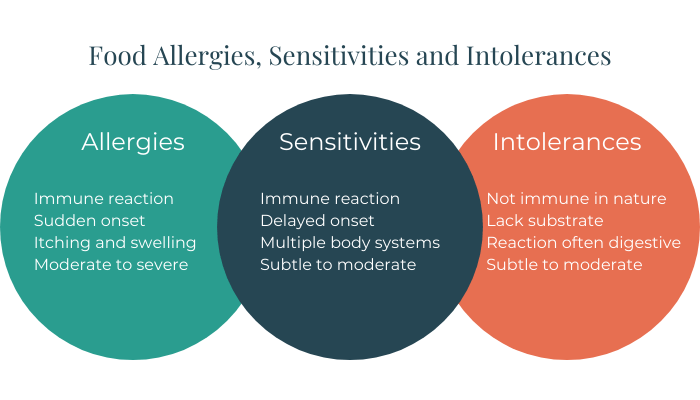The Difference Between Food Allergy, Sensitivity and Intolerance

By Chrissy Hayden, MS, CNS, LMT
February 24, 2021 • Digestion • Nutrition
We’ve been talking about all things food and symptoms this week in the A Holistic Approach to Managing Joint Pain community!
“Why can’t I seem to get started with food and symptoms journaling?”
“I’m tracking my bowel movements, but what does it all mean?”
“What’s the difference between a food allergy, sensitivity and intolerance and how do I know which one might be causing my symptoms?”
These are all questions I've answered, but today, I want to elaborate on the third question and dive deeper into the gut-joint pain connection because this seemingly indirect pathway is often overlooked.
My Own Journey with Food Sensitivities
When I was in my twenties, I had been experiencing pretty persistent bloating and fatigue along with a rash that would appear randomly on my elbows and knees. I decided to see an allergist thinking it must be something I’m allergic to…
The doctor did a scratch test of common allergens and, while I did come up as very allergic to certain trees and grass (major welts!), the areas agitated by things like shrimp, dairy, eggs, and gluten came back as flat as a bike trail in central Florida.
“You have some environmental allergies, but I am sorry, I can’t help with the bloating and fatigue. I’ll prescribe some nasal spray for the spring and summer. Perhaps, try taking a fiber supplement.”

The doctor swiftly exited the treatment room before I could think to ask any further questions.
“Fiber? I eat a ton of fiber.” I was confused and frustrated.
At the time, I had no knowledge of the gastrointestinal system and didn’t know the difference between food allergies, sensitivities and intolerances.
A simple explanation of this would have saved me SO MUCH HASSLE.
I was beginning to think my symptoms were in my head bouncing from doctor to doctor searching for answers. Can you relate?
The allergist wasn’t wrong -- I did not have allergies to food. I had food sensitivities, which I later identified with the help of my acupuncturist.
He took me through a protocol to help me identify what was causing my symptoms and within a week...bloating was gone. I was waking up like a pop tart. No more skin rash. It was like night and day almost overnight after years of suffering.
This might sound too good to be true, but my hope is that I can save you the hassle of going through what I went through because this is a real possibility if you’re suffering from joint pain and other seemingly random symptoms.
So, I am going to start by sharing what the differences are between food allergies, sensitivities and intolerances and I’ll take it a step further and give you a starting point to figure this out for yourself!
The main distinguishing factor is how your body responds to the offending food and WHY, but let’s dive into each so you can really understand what each is all about.

What Are Food Allergies?
Food allergies are an immune reaction that often presents immediately and can range from moderate to severe. If you have a food allergy, you likely know it because symptoms come on quickly and can be life threatening -- the most common being itching and swelling.
This is why they don’t typically serve peanuts, a common allergen, in schools or on airplanes. The body mounts an attack against the protein found in the offending food, so even just a dusting can really set off a violent reaction.
If you have food allergies, you likely know it already. If you suspect this is an issue for you, it is best to work with an allergist. Food sensitivities and intolerances are a bit more subtle, but can make a world of a difference to your symptoms if identified.
What About Food Sensitivities?
Food sensitivities are a more subtle immune reaction to food that can go unnoticed if you just generally feel unwell most of the time. Symptoms can show up even two to three days after you’ve eaten the offending food and can affect one or more body systems.
And here’s the thing…
If you continue to unknowingly beat your immune system over the head with foods that elicit a small war in your gastrointestinal tract, this crucial barrier begins to break down over time.
That’s when you can experience things that are totally unrelated to your gut - like skin rashes, brain fog, mood disorders, and yes, joint pain!
What Are Food Intolerances?
Food intolerances do not directly involve the immune system, but have to do with a lack of substrate to break something down. A classic example is lactose intolerance, where a person doesn’t have lactase, the enzyme, to digest and assimilate dairy properly and this results in symptoms like gas, bloating and diarrhea.
The onset of the reaction is fairly quick, within a couple of hours, making intolerances easier to identify if you pay careful attention.
And that’s what I want to dive into next -- how do you identify sensitivities and intolerances?
Identifying Food Triggers
Being able to put a finger on what is causing your symptoms, and likely a low level inflammation in your body, can be life changing. I have experienced it and have seen it several times with my clients.
I am thinking of one of my recent clients who said when she turned forty, she actually felt ten years younger than she did on her 39th birthday because we removed the food triggers from her diet, healed her gut, and her body wasn’t aching all over anymore.
So, how do we identify them?
On occasion, I do send my clients for antibody testing. Certain labs can test for elevated IgG and IgA antibodies, which are the little soldiers called to action for food sensitivities. However, the gold standard is actually a systematic food elimination and rechallenge.
An elimination and rechallenge is an undertaking and is best guided by a professional. It is a component of my online program, The Freedom From Pain Protocol, for this reason!
Learn the Language of Your Body
But, the first crucial step is really food and symptom journaling. Beginning to learn the language of your body and developing a relationship between what you eat and how you feel!
Documenting your meals, pain, energy, and even bowel movements can yield so much valuable information. You can pick up food sensitivities and intolerances from this exercise alone!
I’ve actually put together a free, step-by-step guide on how to do this correctly and efficiently along with some tips on what to look out for.
In addition to identifying food triggers, this practice is often an eye-opening experience that really brings awareness to your eating habits.

Well, there you have it, my friend. I hope this inspires and empowers you to take an active role in your well-being!
It might feel like magic, but I assure you it’s just knowledge turned into action. Action turned into results! Sounds cheesy, but it’s true.
Do you suspect you have a food sensitivity or intolerance? Feel free to comment below or share this with someone who might need it!
Chrissy Hayden is a functional nutritionist, massage therapist and owner of The Art of Health, LLC. Her primary focus is on helping women turn the dial down on joint pain using natural, evidence-informed interventions. Chrissy lives in Arlington, Virginia, with her husband and two little boys.
Let's Stay in Touch!
Sign up to receive tips, recipes and special offerings to support you in your wellness journey.
© 2023 The Art of Health, LLC
